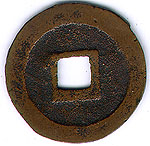|
Here is a Japanese charm. it is called a hidari koma, which means
"pony going left." It has no words but is a humorous view of
a man and his packhorse. Somehow the man seems to be losing.
There is the possibility that what I describe as a man is a monkey.
Monkey and horse coins are also quite common. A complicated system of
beliefs about the various animals' relations to the five elements of earth,
fire, wood, water and metal, makes such coins protection for a horse's
health.
24mm wide x 1mm thick
|
 |
 |
|
Here is another hidari koma but it was made by directly carving
the image into a Kan'ei tsuuhou coin. The original coin is probably a
type from around 1714 called a "shukuji haibun muhai" which
means that it is a later version of the 1660's "bunsen" which
had no bun character on the back, but I am not sure.
This was found in Java, and the carving of the coininto a charm is likely
to have been done in Java (I have seen another Kan'ei tsuuhou similarly
carved with two Javanese dancer images.). It was improperly cleaned with
an abrasive, which makes it look very new but the corrosion in the bridle
and the lines of the rear right legetc. suggests that the carving is not
that recent.
25.5mm wide x 1mm thick
|
 |
 |


























